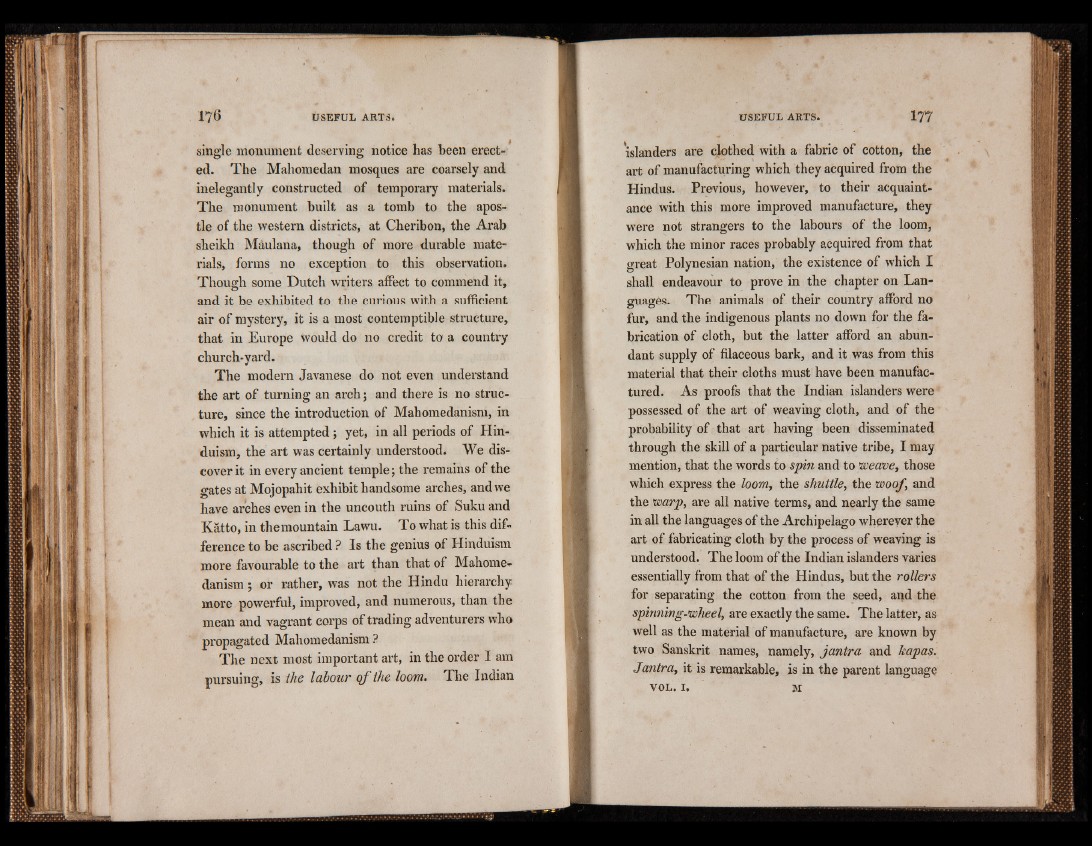
single monument deserving notice has been erected.
The Mahomedan mosques are coarsely and
inelegantly constructed of temporary materials.
The monument built as a tomb to the apostle
of the western districts, at Cheribon, the Arab
sheikh Maulana, though of more durable materials,
forms no exception to this observation.
Though some Dutch writers affect to commend it,
and it be exhibited to the curious with a sufficient
air of mystery, it is a most contemptible structure,
that in Europe would do no credit to a country
church-yard.
The modern Javanese do not even understand
the art of turning an arch; and there is no structure,
since the introduction of Mahomedanism, in
which it is attempted; yet, in all periods of Hinduism,
the art was certainly understood. We discover
it in every ancient temple; the remains of the
gates at Mojopahit exhibit handsome arches, and we
have arches even in the uncouth ruins of Suku and
Katto, in themountain Lawu. To what is this difference
to be ascribed ? Is the genius of Hinduism
more favourable to the art than that of Mahomedanism
; or rather, was not the Hindu hierarchy
more powerful, improved, and numerous, than the
mean and vagrant corps of trading adventurers who
propagated Mahomedanism ?
The next most important art, in the order I am
pursuing, is the labour q f the loom. The Indian
'islanders are clothed with a fabric of cotton, the
art of manufacturing which they acquired from the
Hindus. Previous, however, to their acquaintance
with this more improved manufacture, they
were not strangers to the labours of the loom,
which the minor races probably acquired from that
great Polynesian nation, the existence of which I
shall endeavour to prove in the chapter on Languages.
The animals of their country afford no
fur, and the indigenous plants no down for the fabrication
of cloth, but the latter afford an abundant
supply of filaceous bark, and it was from this
material that their cloths must have been manufactured.
As proofs that the Indian islanders were
possessed of the art of weaving cloth, and of the
probability of that art having been disseminated
through the skill of a particular native tribe, I may
mention, that the words to spin and to weave, those
which express the loom, the shuttle, the woof, and
the warp, are all native terms, and nearly the same
in all the languages of the Archipelago wherever the
art of fabricating cloth by the process of weaving is
understood. The loom of the Indian islanders varies
essentially from that of the Hindus, but the rollers
for separating the cotton from the seed, and the
spinning-wheel, are exactly the same. The latter, as
well as the material of manufacture, are known by
two Sanskrit names, namely, jantra and kapas.
Jantra, it is remarkable, is in the parent language